Cemmaes is a village situated beside the A470, just over six miles east-north-east of Machynlleth, in the county of Montgomeryshire. The village lay on the Mawddy Railway which connected to the main Cambrian Line at Cemmaes Road. The men of the village who fell during both World Wars are commemorated on the Cemmaes War Memorial, which is situated beside the main road, and takes the form of a Celtic Cross. I have also taken the liberty of adding the details of several men of the area who do not appear to be commemorated locally.
The Great War, 1914-1918
Andrew Davies, Lance Corporal, 20366, Welsh Regiment. Andrew was born in Cemmaes in 1877. He was initially raised by his grandmother, Jane Davies, at Gwernybwlch before being adopted by David and Jane Roberts of Cemmaes. Andrew had been living with Mary Jane Swain at The Terrace, Commins Coch for several years, before marrying her in 1910, and the couple had three children, two born out of wedlock. Andrew enlisted into the 5th Battalion, Welsh Regiment at Ynysybwl following the outbreak of war. The battalion was a Territorial Army unit, which mobilised at Pontypridd on 4 August 1914, as part of the South Wales Brigade, Welsh Division. The Division moved to its war station at Pembroke Dock before moving to Tunbridge Wells. Andrew took ill soon after this move, and was invalided home, where he died of pneumonia on 7 February 1915, aged 38. He is buried in St. Tydecho’s Churchyard, Cemmaes. Andrew is not commemorated on the Cemmaes war memorial.
Iorwerth Gwilym Davies, Captain, Royal Air Force. Iorwerth was the son of Edward Hurst Davies and Margaret Davies (nee Evans), of Brynderwen, Aberangell. He enlisted into the Lincolnshire Regiment, and landed in France on 1 March 1915, taking part in the Battle of Neuve Chapelle before being commissioned into the 9th Battalion, South Wales Borderers on 10 March 1915. He went back to England and joined the battalion at Pembroke Dock for training. He then volunteered for the Royal Flying Corps and after training as a pilot was posted to Palestine, where he remained until being granted leave early in 1918 and returned to England again, after being mentioned in despatches. He became an instructor at the 54th Training Depot Station at Fairlop, near Ilford, Essex. On 2 September 1918, Iorwerth was performing aerobatics in Avro 504k D2110 when the aircraft stalled and dived into the ground, mortally injuring him. He died that same day, aged 25. His body was conveyed back to Aberangell, before being conveyed on a gun carriage to Cemmaes Calvinistic Methodist Chapelyard, where he was buried with full military honours on Saturday 7 September, at 13.30. Iorwerth is not commemorated on the Cemmaes war memorial, but is commemorated at Dinas Mawddy.
John Thomas Davies, Private, 73249, Royal Welsh Fusiliers. John was the son of Evan and Catherine Davies, of Brynafon Bach, Cemmaes. He enlisted at Welshpool into the army and after completing his training was drafted to France late in 1917, joining the 2nd Battalion, Royal Welsh Fusiliers. The battalion was in the Ypres Salient, and had suffered heavy casualties during the Passchendaele offensive, whilst attached to 19 Brigade, 33rd Division. The Division wintered in the Ypres Salient, its infantry battalions carrying out the usual routines of trench rotation, and then at the end of January 1918 the 2nd RWF moved to Longuenesse, where the battalion received news it was to transfer to 115 Brigade, 38th (Welsh) Division. On 6 February the battalion marched through the streets of Merville, welcomed into the 38th Division by the band and drums of 115 Brigade, obviously pleased to see such a highly esteemed battalion as the 2nd RWF join its formation, and on 21 February the battalion took over a section of the Divisional front, in the Wez Macquart Sector. On 21 March 1918 the Germans launched Operation Michael, their great offensive, on the front running from Croisilles to La Fère, and broke the Allied line. As a result, the 38th Division was among a number of fresh units rushed south, and relieved the battered 2nd and 47th Divisions in the line facing Bouzincourt Ridge, north of Albert. On 11 April the 2nd RWF moved into reserve at Millencourt and seven days later moved into the front line to begin a routine tour. John was badly wounded here on 22 April, while the 2nd RWF was in support of a minor operation carried out by 113 Brigade. He was evacuated to the 29th Casualty Clearing Station at Gézaincourt, where he died of his wounds on 25 April 1918, aged 19. He is buried in Bagneux British Cemetery, Gézaincourt, France. He is not commemorated on the Cemmaes war memorial.
Thomas Evans, Private, F/2740, Middlesex Regiment. Thomas was the son of Edward Evans and Mary Evans (nee Hughes), of Commins Coch, Cemmaes Road. His father died when he was an infant, and Thomas began work as a farm hand as a young man. Thomas had served with the 7th Battalion, Royal Welsh Fusiliers (Territorials) prior to enlisting at Norwich into the 27th Battalion, Middlesex Regiment on 13 April 1916. His Territorial training must have served him well, as he embarked for France soon after, on 2 July 1916, and on 12 August was posted to the 17th Battalion, Middlesex Regiment, which was in the Arras sector attached to 6 Brigade, 2nd Division. During the middle of July, the Division began to move south, to take part in the Somme offensive, reaching Morlancourt by 20 July, and moved into positions near Longueval, to take part in the desperate fighting for Delville Wood. The Division saw heavy fighting over the coming weeks, before moving slightly north to Serre, and saw further fighting there during the Battle of the Ancre later that year. The Division wintered on the Somme, and in February 1917 followed the German withdrawal to the Hindenburg Line, advancing past Grevillers to Biefvillers before being withdrawn to rest and refit. The Division then moved to the Arras sector, and took part in the Battle of Arras soon afterwards, seeing heavy fighting again over the coming weeks. On 4 June 1917 the 17th Middlesex took over a section of front line in the Fresnoy Sector, to begin a routine tour. Thomas was killed when the German artillery bombarded the battalion’s lines during the evening of 7 June 1917. The 31-year-old has no known grave and is commemorated on the Arras Memorial, France.
John Humphrey Jones, Sapper, WR/340387, Royal Engineers. John was born in Cemmaes in 1879. He was raised by his grandparents, Edward and Jane Jones, at Temperance House, Cemmaes. He married Sarah Ann Foulkes in 1904 and the couple lived at Gwynfa, Cemmaes. John worked as a painter prior to the war. He enlisted into the Royal Engineers on 11 June 1915 and was posted to the Inland Waterways and Docks Companies, RE. The unit, as its name suggests, had been formed to deal with transportation along canals and waterways, and its personnel worked to maintain communication and transportation of food, supplies, ammunition and the evacuation of wounded. John remained on home service for the duration of the war, and was discharged as medically unfit on 17 January 1919. He died at home on 13 August 1923, as a result of sickness aggravated by his wartime service. John is not commemorated by the CWGC and is not commemorated on the Cemmaes war memorial.
Lewis Jones, Private, 9526, Welsh Regiment. Lewis was born at Llangefni in 1889, the son of John Ellis Jones and Mary Jones. He enlisted into the Welsh Regiment at Cardiff on 8 August 1907, and was posted to the 2nd Battalion, Welsh Regiment. The battalion moved to France at the outbreak of war, attached to 3 Brigade, 1st Division. The Division had been one of the first to arrive in France, fighting at the Battle of Mons, and taking part in the retreat to the Marne, reaching Soissons by 30 August, and then La Ferté-sous-Jouarre, where the Germans were stopped by a combined French and British counter-attack. The Allies then drove the Germans back north to the Aisne, where they again defeated the Germans, before the BEF transferred north to Flanders, the 1st Division detraining at Hazebrouck on 19 October before moving to Poperinghe. The 1st and 2nd Divisions then advanced towards Roulers, digging in beyond the village. The Germans struck towards Langemarck on 23 October, suffering terrible losses from accurate and rapid British rifle fire from its well-trained troops. On the following night the 1st Division was relieved and took over positions east of Ypres, digging in and preparing for a new offensive. The Germans launched their first attack here on 29 October, but were forced back by a counter attack by 3 Brigade. On the following day the Division worked hard improving its defences, then on 31 October 1914, the most critical day of the war so far, the Germans launched a massive assault along the Menin Road towards Ypres. Desperate fighting raged throughout the day, and the 1st Division was almost annihilated, but somehow managed to stop the Germans taking Ypres. Lewis was posted as missing during the terrible fighting of 31 October 1914, and was later adjudged to have been killed in action on that date. The 25-year-old has no known grave and is commemorated on the Ypres (Menin Gate) Memorial, Belgium. By now his parents were living at 3, Uwch Afon, Cemmaes, but Lewis is not commemorated on the Cemmaes war memorial.
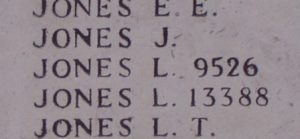
Richard Lewis, Gunner, 159357, Royal Field Artillery. Richard was the son of David and Margaret Lewis, of Chapel House, Darowen, Cemmaes Road. He worked as a waggoner at Tanllan Farm prior to the war. Richard enlisted into the Royal Field Artillery at Preston, Lancs, and was posted to Z/47th Trench Mortar Battery, RFA, which was attached to the 47th (2nd London) Division. The Division fought at the Battle of Aubers, and the Battle of Festubert during May 1915 and in September fought at the Battle of Loos, and subsequent Action of Hohenzollern Redoubt. The Division was north of Arras when the Germans attacked Vimy Ridge, and then moved south to the Somme, where it fought at the Battle of Flers-Courcelette, and then at the Battle of Le Transloy, capturing Eaucourt l’Abbe, and took part in Attacks on the Butte de Warlencourt. Early in 1917 the Division moved north to Belgium. Richard was killed in action soon afterwards, on 4 February 1917. The 21-year-old is buried in Railway Dugouts Burial Ground (Transport Farm), Belgium. He is not commemorated on the Cemmaes war memorial.
Rowland Morgans, Private, 290276, Royal Welsh Fusiliers. Rowland was the son of David And Catherine Morgans, of 3, Dovey Terrace, Cemmaes. He worked as a farm labourer prior to the war. Rowland enlisted at Newtown on 14 August 1914 into the 1/7th Battalion, Royal Welsh Fusiliers. The battalion was a Territorial unit, which mobilised for war at Newtown in August 1914, as part of North Wales Brigade, Welsh Division and moved to Conway until the end of the month, before moving to Northampton. In December the Division moved to Cambridge and then in May 1915 to Bedford, where the Division was numbered and the formation became 158 Brigade, 53rd (Welsh) Division. On 19 July 1915 the entire Division sailed from Devonport for Imbros and on 9 August 1915 landed at Suvla Bay. Rowlands did not embark for Gallipoli at the time, but remained at Bedford with the 2/7th Reserve RWF. He embarked at Devonport aboard the SS Kalyan on 31 May 1916 and joined A Company of the 1/7th RWF in Egypt, some months after its evacuation from Gallipoli. The Division had moved to Egypt to join the EEF, and helped guard the Suez Canal before taking part in operations to drive the Turks out of the Sinai. The EEF then turned its attention onto driving the Turks out of Palestine, and on 26 March 1917 launched its first offensive against the coastal city of Gaza, which guarded the road to Jerusalem. Initial gains during the day were lost when the assaulting divisions lost touch with each other and communication broke down when a thick fog cloaked the battlefield. Rowland was killed in action during the fighting that day. The 26-year-old has no known grave and is commemorated on the Jerusalem Memorial, Egypt.
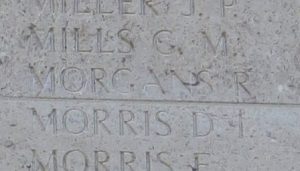
Leopold Grantley Norton, Lieutenant, Durham Light Infantry. Leopold was born at Cowbridge on 23 July 1890, the son of Colonel Reuben Norton and Mrs Evelyn Norton (nee Frosty). The family then purchased Dolcorsllwyn Hall, Cemmaes. Leopold was commissioned into the Durham Light Infantry in 1912, and following the outbreak of war embarked for France with the 2nd Battalion, Durham Light Infantry, which was attached to 18 Brigade, 6th Division, disembarking at St. Nazaire on 10 September 1914. The division arrived in time to reinforce the hard-pressed BEF on the Aisne, taking over trenches north of Troyon on 19 September, and after several days moved to Vendresse, the 2nd DLI suffering some casualties during this period before the whole army was moved north into Flanders. By 15 October the 2nd DLI had taken over positions at Bois Grenier, just south of the Belgian border and on 18 October carried out an assault against the Germans to test their strength. The battalion then enjoyed a day out of the line to rest but on 20 October 1914 was sent back into the line to support the East York’s at Paradis, and carried out two unsuccessful attacks against the Germans, to try and capture La Valée, suffering heavy casualties. Leopold was posted as wounded and missing during the attacks that day. No trace of the 24-year-old was ever found, so he was officially recorded as being killed in action on that date. He has no known grave and is commemorated on the Ploegsteert Memorial, Belgium.
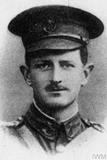
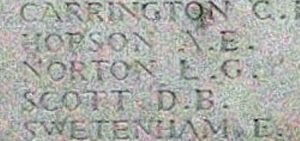
George Griffiths Parry, Private, 55996, Royal Welsh Fusiliers. George was the son of John and Elizabeth Parry, of Bryn Hyfryd, Cemmaes. He enlisted into the 7th Battalion, Royal Welsh Fusiliers at Machynlleth and in the spring of 1917 was drafted to France, being posted to the 15th Battalion, Royal Welsh Fusiliers, which was at Ypres attached to 113 Brigade, 38th (Welsh) Division. The Division had moved to Ypres following heavy losses at Mametz Wood in July 1916, and had taken over the Canal Bank sector at Boesinghe, north of Ypres. Over the coming months the Divisional troops had worked hard, improving the defences and constructing deep dugouts and saps, in preparation to take part in the opening of the Third Battle of Ypres on 31 July 1917. The 15th RWF had spent much of July training at Flechin, moving back to Proven, just behind the lines, on 18 July, and on 23 July moved back into positions in the front line. On 27 July one Company of the 15th RWF was sent out to investigate reports from an RFC aircraft that the Germans had withdrawn, but suffered heavy casualties upon reaching the German lines, as the reports had been incorrect. Nevertheless, the battalion remained in the line and continued to prepare for the launching of the great offensive, the Division being tasked with the capture of Pilckem Ridge. At dawn on 31 July 1917 the Division went over the top, and the 15th RWF, for their part, captured its objective of Iron Cross, before consolidating its gains. George was killed in action during the days fighting. The 28-year-old has no known grave and is commemorated on the Ypres (Menin Gate) Memorial, Belgium.

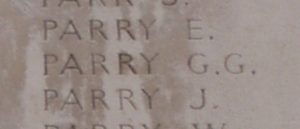
Alfred Edward Wells, Master at Arms, 130203, Royal Navy. Alfred was born at Marylebone on 24 January 1870, the son of Edward and Emily Wells. He enlisted into the Royal Navy on 24 January 1888, and received his first posting aboard HMS Impregnable. Alfred then had a number of postings over the coming years. He married Alice Eileen Rose whilst based at Portsmouth in 1910, and Alice moved to The Retreat, Cemmaes, while Alfred was away at sea. At the outbreak of war Alfred had risen to the rank of Master at Arms and was serving at HMS Victory, and on 18 December 1914 was posted aboard the requisitioned armed merchant cruiser, SS Bayano. On 11 March 1915 Bayano was on patrol in the North Channel on the Glasgow to Liverpool route, when she was attacked by the German submarine SM U-27, about ten miles west of Corsewall Lighthouse, Galloway, Scotland. The cruiser sank in just five minutes, with the loss of around 200 lives, many of which were later washed up on the Isle of Man. Alfred was 45 years old when he died during the sinking of Bayano, and is commemorated on the Portsmouth Naval Memorial, Hampshire.
Second World War, 1939-1945
Idris Gwynfryn Lewis, Private, 7362755, Royal Army Medical Corps. Idris was born on 20 December 1918, the son of Lewis and Margaret Anne Lewis, of Cwmllinau, Cemmaes. He lived at Talgarth Cottage prior to the war, when he enlisted into the Royal Army Medical Corps. After completing his training, Idris was posted to ‘A’ Company, 132 Field Ambulance, RAMC and was probably posted out to North Africa with the unit, before it took part in the landings in Italy in 1943. Idris died in Italy on 11 October 1944, aged 25. He is buried in Faenza War Cemetery, Italy.
Hugh Owen, Driver, T/173690, Royal Army Service Corps. Hugh was born on 26 February 1916, the son of William Owen, of 1, Uchyrafon, Cemmaes. He worked as a lorry driver prior to enlisting into the Royal Army Service Corps, and was posted to the Sudan. Hugh was killed in the Sudan on 26 May 1941, aged 25. He is buried in Khartoum War Cemetery, Sudan.
William Pugh, Aircraftman 1st Class, 542863, Royal Air Force. William was the son of William Pugh and Mary Pugh (nee Evans), of Commins Coch. He enlisted into the Royal Air Force prior to the war and was posted out to France with 98 Squadron, RAF in 1940. The Squadron was based in Nantes, but had no time to take part in the desperate fighting to attempt to save France from German occupation, before being forced to evacuate to the coast. Following the German Blitzkrieg, the various elements of the BEF, as well as countless civilians, had been forced to withdraw to the French coast for evacuation. The thousands of troops who had made it to Dunkirk had already been evacuated by 6 June, whilst more had been evacuated from Boulogne, Calais and Le Havre by 25 May. More Allied troops had managed to reach ports in other parts of France, stretching from Cherbourg down to Bayonne, so the British organised Operation Aerial, to evacuate Allied forces and civilians from western France. William had managed to reach St. Nazaire with most of his squadron. On 17 June 1940 the requisitioned RMS Lancastria steamed into the Loire Estuary and anchored in the Charpentier Sounds. By the afternoon Lancastria had taken aboard a huge number of evacuees, far greater than she was built to carry, with estimates running from 4,000 to 9,000 people. The Germans had already begun attacking shipping in the area, and at 15.50 Lancastria was attacked by Junkers-88 bombers and sank in less than 20 minutes. An estimated 6,500 people drowned in the sinking of Lancastria that day. William was 20-years-old when he drowned in the Loire that day. His body was never recovered and he is commemorated on the Runnymede Memorial, Surrey.
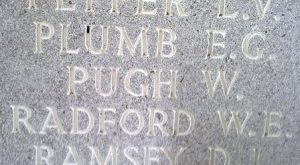
Douglas Grove Wheeler, Lance Corporal, 7888163, Royal Warwickshire Regiment. Douglas was born at Southampton in 1918, the son of Harry John Wheeler and Rosa Jane Wheeler (nee Vowles). The family moved to Dolcorsllwyn Lodge prior to the war after Harry gained a position as Chauffeur and Gardener for the Aderne’s at Dolcorsllwyn Hall, Cemmaes. Douglas was serving with the 2nd Battalion, Royal Warwickshire Regiment prior to the war, and married Cecilia Timms, at Warwick, in 1940, just prior to embarking for France with the battalion, as part of the BEF. The 2nd Warwick’s was given the task of keeping open the main supply route to Dunkirk, and fought a rear-guard action at the town of Wormhoudt in May 1940, when attacked from the direction of Esquelbecq by three SS Battalions. After eight hours of desperate fighting, the Warwick’s were over-run, and a number of survivors were rounded up and herded into a milking shed, together with some prisoners from the Royal Artillery and 4th Cheshire’s. Some men of the SS Leibstandarte then threw grenades into the shed and opened fire with machine guns, killing more than half those inside. The survivors were taken prisoner a few days later by the regular German army and taken into captivity, whilst the SS troops responsible for the massacre never faced justice. Douglas was killed at some time between 19 and 21 May 1940, but it is not known of he was involved in the massacre. The 22-year-old has no grave and is commemorated on the Dunkirk Memorial, France.